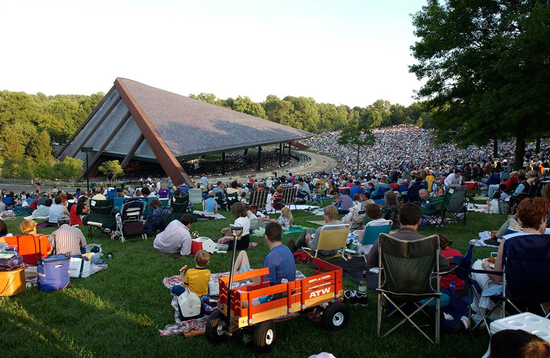In 2010, The Cleveland Orchestra created the Center for Future Audiences. As its name suggests, the Center was created to fund programs that will generate interest in the orchestra’s activities among the youth of Northeast Ohio. The Center received a lead endowment gift of $20 million from the Milton and Tamar Maltz Family Foundation. Milton Maltz has said, “Let’s face it, if we don’t get young people involved in classical music, in theater, in the arts, the opera, ballet: There won’t be the arts of tomorrow.” The Center is charged with the task of making sure there will be a future for classical music in Cleveland.
There are several programs that comprise the Center for Future Audiences. The 2011 Blossom Festival saw the beginning of Under 18s Free, the flagship program for audience development. The goal of this program was to create an inexpensive way for families to attend Blossom Festival concerts. The program offers two free lawn passes for children under the age of 18 with the purchase of each regularly priced adult lawn ticket. There were an average of 700 Under 18s Free passes handed out for each Blossom Festival concert of The Cleveland Orchestra during the program’s initial season. The program was so successful that it was extended to include select Severance Hall concerts throughout the winter season. For concerts at Severance Hall, the program offers one free ticket for children ages 7–17 with the purchase of one regularly priced adult ticket. The average number of Under 18s Free tickets that are issued each year to attend concerts by The Cleveland Orchestra has risen to 22,000.

Blossom Festival concert
Courtesy of The Cleveland Orchestra
The Center for Future Audiences has also taken control of an already existing program aimed to offer students a sizable discount for attending concerts. The Student Advantage Program is designed to allow admittance to high school, college, graduate, and post-graduate students for $10. While enrollment is required, membership is free and it offers the discounted student rate for most concerts during the Severance Hall winter season. Students that take advantage of this program are invited to attend open rehearsals of The Cleveland Orchestra and also attend masterclasses given by guest soloists and members of the orchestra. Social media has also been brought into the mix with postings on the Student Advantage Facebook page announcing upcoming concerts that are available for students to attend at the $10 rate. Thanks in part to this program, college student attendance rose 50% in 2014. Between the Under 18s Free and the Student Advantage Program, this season saw the 100,000th student/youth concert attendee since the program’s inception.
In the fall of 2012, the Center launched another offering for members of the Student Advantage Program. The Student Frequent FanCard was created to assist students that would like to attend more than the occasional performance. A FanCard for one season costs $50 and it allows the student a single ticket to any weekly subscription concert. There is no restriction on the number of concerts the FanCard can be used for.
The Center also created a Student Ambassadors program. Each season the orchestra recruits up to 20 college and graduate level students to promote awareness of the Student Advantage Program on college campuses in Northeast Ohio. Student Ambassadors promote orchestra activities to faculty and students of local colleges and universities. Participants in this program receive a free Student Frequent FanCard and work with the marketing department of The Cleveland Orchestra.
It is clear that The Cleveland Orchestra is an institution in transition. The organization is changing its business model and is striving to become an ever greater asset to the communities it serves. The organization is targeting a more diversified audience base. Getting younger audience members to attend performances on a regular basis is an ambitious goal, but it is a goal that The Cleveland Orchestra is dedicating itself to achieving. It appears to be working. When the Center was created in 2010, student attendance was 8%. As of this season, student attendance is over 20%. Focusing energy on younger audiences is a key to ensure that every orchestra will have an audience in the future.





